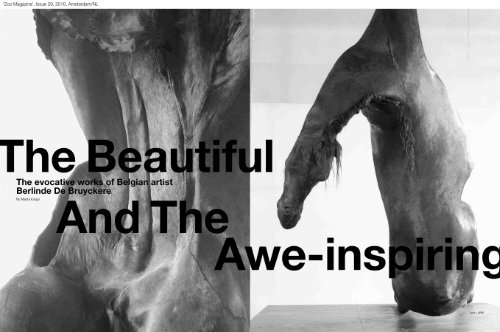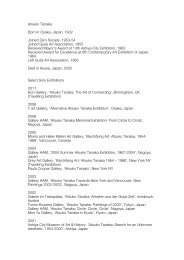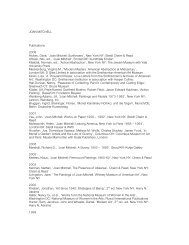Untitled - Hauser & Wirth
Untitled - Hauser & Wirth
Untitled - Hauser & Wirth
- No tags were found...
You also want an ePaper? Increase the reach of your titles
YUMPU automatically turns print PDFs into web optimized ePapers that Google loves.
Interview_Berlinde De BruyckereThe muffled cry of the unrealizable desire,2009-2010Berlinde De Bruyckere is one of the starartists in the worldly firmament. In herhuge studio in Ghent, a building that wasonce a Catholic school for boys, sheshows me some of her awe-inspiringworks. The austere classrooms have beentransformed into working studios full ofsculptures, objects, photos and books.The headmaster’s home has been turnedinto a residence for De Bruyckere and herfamily. We look at powerful photos of anathletic young man bound to a pile andfrozen in several convoluted positions.Berlinde De Bruyckere: For my new work—astatue that refers to the figure of SaintSebastian—I made a photo series of thisnaked man whom I bound to an old columnthat I found at the train station. Saint Sebastianis a strong, old iconic image; an ambiguousfigure that seduces but is dying at the sametime; someone who defies the beauty of hisbody as if he wanted to transform it into ahigher level; an image full of homoeroticconnotations; an image that, in my opinion,we can also see today in fashion magazines,the news, and around us. When I look atold paintings of Saint Sebastian, I have theimpression that despite the arrows that stickinto his body, he is untouchable and feels nopain. I imagine that the arrows are the gazeof the painter; they cannot resist the beautyof the saint so the only possibility is to killhim. As in the amazing film Sebastiane byDerek Jarman, the unattainable beauty mustbe destroyed.Marta Gnyp: Your knowledge of art historyis very prominent in your oeuvre. Do youintentionally want to be in a dialogue withthe Old Masters?BDB: I will have a museum show in Halle nextyear that will be a confrontation between theworks of Lucas Cranach and Pasolini and myown. Cranach has fascinated me for a longtime because of his formal language and hisapproach towards the body: his elongatedfigures, strange proportions, the blackbackground that releases the figures fromtheir dependency on the context—all theseaspects have influenced my way of thinking.His subjects were morbid and cruel butthere has been always the ambivalence andambiguity between how the form fits into thesubject: there is the death but no blood; thereis a sword that kills, but at the same time, thegentle touch of the victim. In a similar way, Ifeel a strong connection with the stress on thebody and its sophisticated, visual language. Acombination of a sense of beauty and realityis also a departure point for Pasolini: he isable to make a real angel from his actress. Butto achieve this effect, he will endlessly repeateach scene and will be involved in setting upthe image right to the tiniest of details. I seesimilarities in my approach. I let my modelsundergo a metamorphosis by disclosing tothem my ideas about the final image and itsemotional connotations, so they can dig intothemselves and search for these particularemotions. I show my drawings to the modelsin order to explain what I want and ask themto translate it into an image. During a photosession, I request the model to take a specificposition. Their bodily and mental translationsare highly personal but able to express myoriginal concept at the same time. Perhapsit’s because while selecting my models, Iintuitively sense who can best transform hisemotional depth from my ideas.MG: You often seem to work intuitively.What does intuition mean for you?BDB: It means to trust what you feel isintuition. When I’m in my studio, I’m notsearching what to do; something is alreadythere. That feeling has to be translated intoan idea and later into an image. Listen towhat there is and what can grow, to give itthe freedom and trust to let it happen. Don’tbe content with just the first layer. Intuition issomething I learn to trust in the moments Idoubt about my work.MG: Coming back to your intuitive choice ofmodels, do they understand what you askfrom them?BDB: It is very important for me that they realizethat the original idea and the final work are notthe same, that perhaps they will not recognizethemselves in the image. I want them to bewarned that their bodies will finally not betheirs. One of the models refused his bodymodel to be used after he saw what would bethe end result. I can imagine such a reaction—the object starts its independent, visible lifeafter he leaves my studio; it becomes a fetish.MG: You cannot transform only the body.You need to change your mental attitudefirst.BDB: Exactly.MG: In many of your works, the body isopened by a wound. Does the wound havea special meaning for you?BDB: The wound is a sign of being, a holethat makes you aware that the body has aninside. Through the wound, our inner sidecan be visible to the outside world, which isan essential existential experience. SimoneWeil once said, “Out of the wound the wingscan grow.” For me, the wound is a sign ofchange, a gate to another sphere, to a newlife—if we think about it, the vagina is awound—to another state of consciousness,because feeling pain—obviously dependingon the intensity of the pain—can makeyou forget about thinking and reduce youto a flesh experience. At the same time, ifspeaking in religious terms, this experiencemeans a stage of transcendence. I wasinspired by the way Pasolini and Cranachshow wounds, showing sexual, physical andbodily fascination at the same time.MG: This physical aspect, the body andflesh, dominates your oeuvre. I readthat your father was a butcher. Did thisinfluence your attitude towards the fleshand body? You must have seen many deadanimals and meat as a child.BDB: I regularly saw big and strong menin white aprons carrying dead animals. Iwas never afraid of them. I have never feltrevulsion for death or anatomy or blood. Irealize that those memories play a big rolein my unconsciousness, but consciously,the connection is not that direct. I work withdead animals; my point of departure is, forexample, a dead horse, but only to transcendit into an image that can heal, that can showmany aspects of life, love and lust in theirclarity and purity.MG: Several times when I have describedyour work as ‘beautiful,’ I was told that theyare not so much beautiful but disturbingand moving—the beauty and the sublime.BDB: For me, both categories are importantand applicable. In a sublime experience,there are magnificent moments. This is notonly about fear and dread, but there is alsosheer beauty. These emotions I try to showin my work and to provoke a discussionabout these two sides. For example, theemotion of the Pieta is in essence very sad,but thanks to its pictorial quality, vulnerability,and the apparent fragility of the material, itcan appeal to other feelings: softness againstthe harshness of the world. My objects aremalformed but they give you the feeling ofbeauty.MG: Where does your idea of mancome from? (Fragmented, malformed,distorted?)BDB: Since the beginning of the 90s, I havebeen working with the human anatomy: firstly,with women covered by blankets where onlyparts of their feet were visible. Soon after, Isewed objects together: various body partswere literally sewn together to form a newman. Human beings are not one piece. Weare made out of various fragments, whichall together form what we call a unity; thefragments, the memories that are importantnow are of no importance tomorrow andperhaps will exist only in our memory.Our curves are liquid and the totality verycomplex. I like to work from the reality of thebody because I know it very well. Taking thebody as the departure point, I can refer touniversal themes and put the body on a levelwith mankind. In my work, I try to express5ZOO MAGAZINE_2010 NO.29
then it becomes immediately the referencepoint and makes the sculpture too easilyaccessible. I don’t want to direct the attentionto the face because only a total image hasmeaning.MG: Speaking of the personal, whendid you realize that you wanted to be anartist?BDB: As a child, you don’t know what anartist is. But if I think of it, actually I wasalways one. It took a while to put the wishinto a convincing form. When I was 16, I wentto the academy, but without taking a realdecision and without having real faith that Icould do it. I had to fight with my parents, whoinitially agreed to let me attend the academy,but they did not see it as leading to anyserious job possibilities. I rented a studio inGhent and gave drawing lessons to make anincome in order not to be independent frommy artistic work. This is why I could makewhat I wanted, and what was not accepted.In the beginning, I was not selling at all,but it was never a problem. I knew I had tocontinue. I’m still busy with the same themesand forms, geometric and masculine. I madecages, which I still find very strong. There iscontinuity in my work: the cage works treatedthe same themes, which are important for menow. The difference is that the iron cage hasbeen replaced by a human body.Lost, 2006doubt, perhaps because of my aversion toso-called certainties that, in my opinion, areno longer applicable to our times. We aresearching for rules and habits to survive, butwe keep on doubting.MG: Have you ever used yourself as amodel?BDB: Never. But at this very moment, I’min the process of making a self-portrait. Itrefers slightly to my favorite male portrait,Christ Crowned with Thorns, painted by the15 th century painter Antonello Da Messina,which I try to see every time I’m in New York.What is so interesting is the open mouth:the man wants to express something buthis expression is immediately suppressed.I can recognize myself in this attitude. Myobjects are very extroverted, but they are notshouting. I want to make a self-portrait as aman-like horse torso—he looks away with ahalf-open mouth, a bated but present shout.MG: Is this how you experience themeaning of your art in the world?BDB: If I agree, I would immediately be calleda moralist. But often when I see exhibitionsby other artists, I find my own art oldfashioned.Recently, I visited the biennale inGwangju, whose motto was ‘10,000 lives,’ anold Korean poem. The idea of 10,000 livesshows that a human’s singular life is verylimited—that it poses no urgency in the worldwithin a bigger context. My personal story isonly important for myself, but if I can touchsomething that is universal, then it makessense. The most touching moments for meis when a viewer can find consolation inmy work—that I created an image that hasmeaning.MG: How personal are your works?BDB: They come into being from a personalurgency, a personal question which is relevantfor me, not from outside. They are the resultof a passionate need to get in contact withthe world and community.MG: Why do you never make faces?BDB: Because the communication betweenthe image and the viewer should go throughthe totality. If you give a sculpture a face,MG: Have you never felt the necessity toleave Ghent? You have been living hereyour whole life.BDB: This place is great. I have a huge studiothat I have been using for 22 years already.This place is full of memories of earlierimages and it’s meaningful for me, so I canalways find here the peace of mind that I needto work. Besides that, it is very practical: Ihave a great house, close to nature and tothe airport if I want to go abroad. I love totravel and I do it a lot. But to work, I needthis place.MG: Have you seen your works in thehomes of collectors? How do your worksfunction in a living space? They require somuch attention...BDB: I sometimes install my own works incollectors’ homes, which can feel strange.Recently, I visited three collectors in theUS who have several works made by me.The three were so completely different. Ina New York apartment, my work stood inthe middle of the living room between OldMasters, African masques and contemporaryphotography. The owner assured me thatthe object became a member of the family.It was beautiful to see because each singlework has for them a meaning and a reasonto be with them. That is for me the ultimateexample of how art can live its own life.Letsel, 2008ZOO MAGAZINE_2010 NO.29 6
We are all flesh, 2009Berlinde De Bruyckere is represented by <strong>Hauser</strong> & <strong>Wirth</strong> (London, New York and Zurich)and Yvon Lambert (Paris and New York)www.hauserwirth.com www.yvon-lambert.comZOO MAGAZINE_2011 NO.29 8




